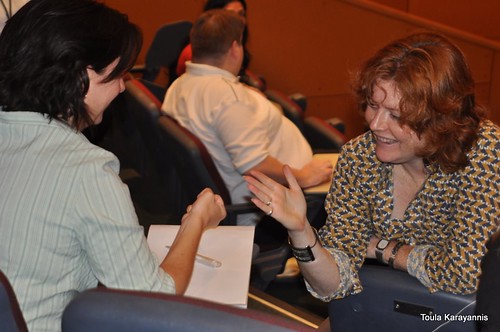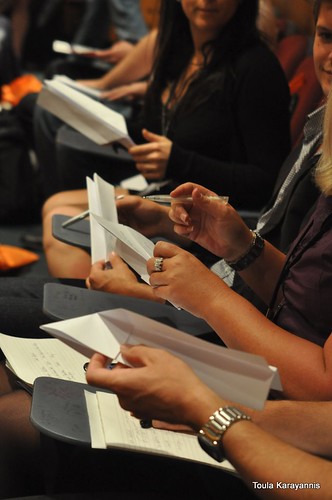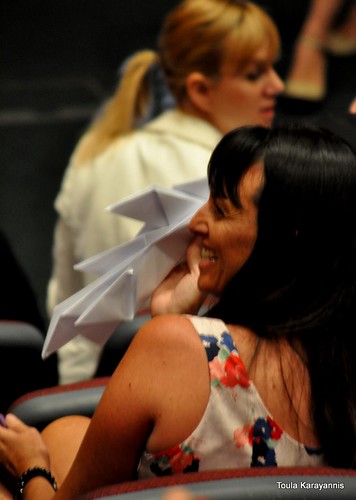| |
Friday, 30 April 2010
Everything as a service
You've heard of software-as-a-service; I believe a big change needed for the 21st century is to see every piece of communication as a service.
What does software-as-a-service do? It enables people to do things for themselves.
When you think of how to deliver a message, how can you make that message an experience, a facilitator that lets people do something that's useful or helpful for themselves?
For example, a bus-stop-ad for hearing awareness week had a way to check if your iPod was turned up too loud (just put your earbud into a sensor). It was information, but then it enabled you to make that information personally relevant to you.
How can you make your advertising or marketing communications more useful?
Thursday, 15 April 2010
Social Business: Innovation and Storytelling: Connect Now
via Get Shouty by katiechatfield on 4/14/10
My notes:
The theme: One of the fundamental challenges organisations have is in developing a culture of innovation and inspiration- and building the teams and behaviours that will share and collaborate in order to achieve this. Where do you start? And how do you feed the fire?
Chart 13:
Change management is a scary word
It’s difficult, lengthy and expensive
Is technological change environmental change?
Chart 14:
(from Mumbrella’s coverage of the APG Battle of the Big Thinking Battle of Big Thinking part 1: Creating unique brands; Changing the world; Perth vs Sydney
Speaker: Peter Williams – CEO, Deloitte Digital
Topic: The formula for changing the world
Quote: “Any match in the box can start a fire.”
His argument:
That rather than chasing influencers, brands need to understand that when a population is ready to go through a phase transition anything can be a trigger if you understand it.
Using a home experiment involving a bottle of beer from the freezer, he showed how once one molecule of beer freezes (or changes phase), the transition moves to the next.
He also challenged the audience to clap in unison, and with no other obvious organisation, the room fell into rhythm within about a second.
He argued that formula for changing the world is simply having a self-influencing population that is ready to make that phase transition, and a trigger.
Chart 15:
Phase transition is more than synchronicity
You need to design the ‘what’s next’- because you’ll lose momentum and the potential for shift if you stop supplying new triggers and adapting the rules.
This formula’s potential describes the building blocks of change
It’s a process- an organic model that lives. It’s not set and forget.
It’s about creating an environment and prompts for adapting the simple rules and the trigger
Because phase transition is a chain reaction- you need to keep feeding the loop
Chart 16:
“Any match in the box can start a fire.”
“The ability to combine knowledge and information in a new way is important. Just because you have knowledge and information does not mean you are a creative person. But it is also impossible to be a creative person without knowledge and information.”
http://knowledge.smu.edu.sg/article.cfm?articleid=1267
Chart 20
This exercise was inspired by Helen Hasan’s presentation at the NSW KM Forum – February Triple Threat.
At it’s heart:
- You ask participants to find someone they don’t know and negotiate a game of PSR
- (this can usually be seamlessly achieved
- Then you ask that ‘team’ to find another pair and negotiate another game (with no further explanation)
- What was a simple and explicitly understood task becomes a lot more complex….and chaotic
- …. what will happen next?
Helen Hasan is Associate Professor in Information Systems at University of Wollongong. She has been a member of the KM committee of Standards Australia since its beginning and is proud of her role in writing the Australian KM Standard released in 2005. Her research areas relate to an innovative aspect of KM that she now refers to as ‘Sensible Organisation’. She has published widely in academia and she has applied her research findings in numerous consulting projects.
Photo credits:
Chart 23
http://threexthree.wordpress.com/
Chart 24
Chart 26
The management team also used this structure to present quarterly back to the team
Chart 36
This diagram was created for my chapter of ‘Age of Conversation’
What it says is that you’re never more than 2 steps from disaster….
And with the tenure of marketers….why would they take that risk ?
Chart 39
Blog coverage: From State of Flux :
Can I explain what I do to my Mum? Katie Chatfield highlighted that we are working in a field that is quite complex and that has a new language. Don’t use jargon and discourse people don’t get, people need to understand your ideas to take them up. Use language as a tool to transfer your idea to the next person, when your trying to translate an idea to someone, it needs to be a story they can tell to other people.
Chart 43
Blog coverage: State of Flux:
Jack’s Show and Tell
Katie Chatfield introduced us to her company’s concept – Jack’s Show and Tell. This is cool! Company gets together to “build a titanium culture” recognises and awards work that changes the game. Gives people a chance to learn to tell great stories. Once a month, brought to you by the strategy, creative and design team. It is show and tell for grown ups and not a lot has changed since Year 3 at school. Simple stories, powerful experiences, transferring knowledge and a chance to look at how someone looks at the world
Chart 47
Ralph was inspired by the ancient (and, sadly, lost) art of haikugami, where the traditions of haiku are melded with those of origami to create beautiful and functional poetry.
In this entertaining and interactive presentation, Ralph shows what’s possible with 500 people, 5 minutes, and lots of pieces of paper!
See his fab presentation and some of the creations
Chart 49
Photo credits:
Chart 50
Photo credits:

The Barkly Social Club - Participate with Purpose. Engage with Emotion
Another marvellous summary of Connect now Link: http://barkly.tumblr.com/post/517741772/participate-with-purpose-engage-with-emotion
Ameel's Career & MBA Exposition » Blog Archive » ConnectNow 2010 – Thoughts & Notes (Part 2)
Link: http://insanityworks.org/acme/2010/04/13/connectnow-2010-thoughts-notes-part-2/
Awesome summary, extensive notes and links.
Wednesday, 14 April 2010
Asking powerful questions
At Friday's workshop on Storytelling, I mentioned a document around asking the right questions to generate the most helpful stories. I've been helped by this document. Hope you enjoy it:
Tuesday, 13 April 2010
Unsung heroes of Connect Now
Over the three days of Connect Now we got to see some amazing people up front. There were also some amazing people behind the scenes. Here are some of them (I'm sure I will have forgotten some)
For blogging:
Gavin Heaton @servantofchaos for providing thoughtful context on this blog and through his Twitter feed.
Warlach for providing an alternative live coverage of the event, again providing context and perspective. His first, second and third day coverage.
For being an integral part of the conference experience:
Toula @digitalkulcha
Matt @Mattimck
Jade Craven @jadecraven
Lisa @lovewinenz for keeping us on time, all the time (and looking after our speakers!)
Stephenie Rodriguez @digitalgodess for berocca, livestreaming and just being awesomely supportive.
And of course, Siobhan Bulfin, for being audacious enough to not just dream it, but do it.
Information overload is a filter failure « damon klotz – thehrockstar & network-king
Great post that came out of #cnow. Link: http://damonklotz.wordpress.com/2010/04/12/information-overload-is-a-filter-failure/
Monday, 12 April 2010
RT @Nightwyrm: Sign the Wellington Declaration TONIGHT and FIGHT ACTA for your Internet rights! http://tinyurl.co...
RT @Nightwyrm: Sign the Wellington Declaration TONIGHT and FIGHT #ACTA for your Internet rights! http://tinyurl.com/y6vg9rl (this is international!)
via SimplyTweet
Sunday, 11 April 2010
RT @estateofflux: RT @TeamXero On the Xero blog: Social marketing "blowing up traditional advertising business mo...
RT @estateofflux: RT @TeamXero On the Xero blog: Social marketing "blowing up traditional advertising business models" http://bit.ly/dprnXZ via SimplyTweet
Thursday, 8 April 2010
My sister's desk calendar. Seems strangely appropriate at this hour

via SimplyTweet
Tuesday, 6 April 2010
Subscribe to:
Posts (Atom)













